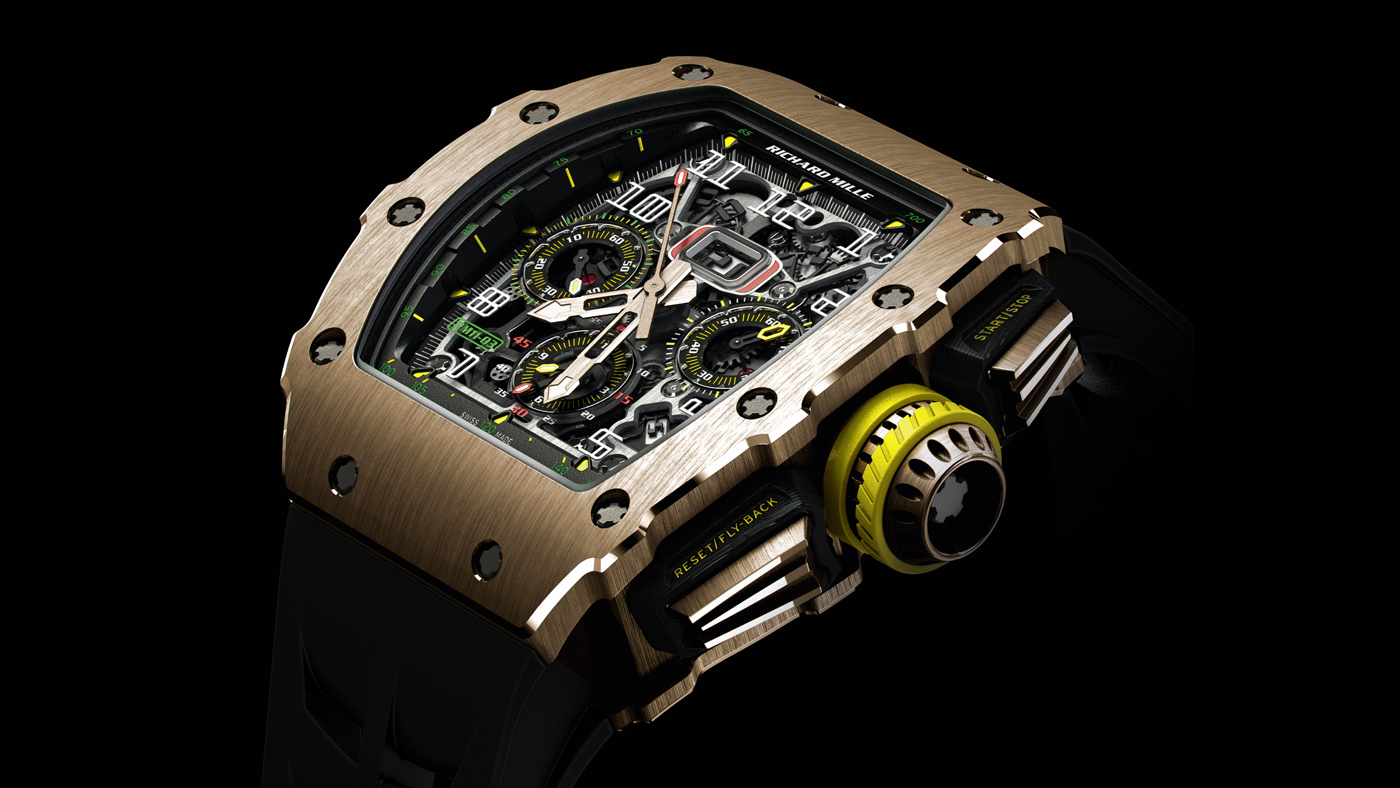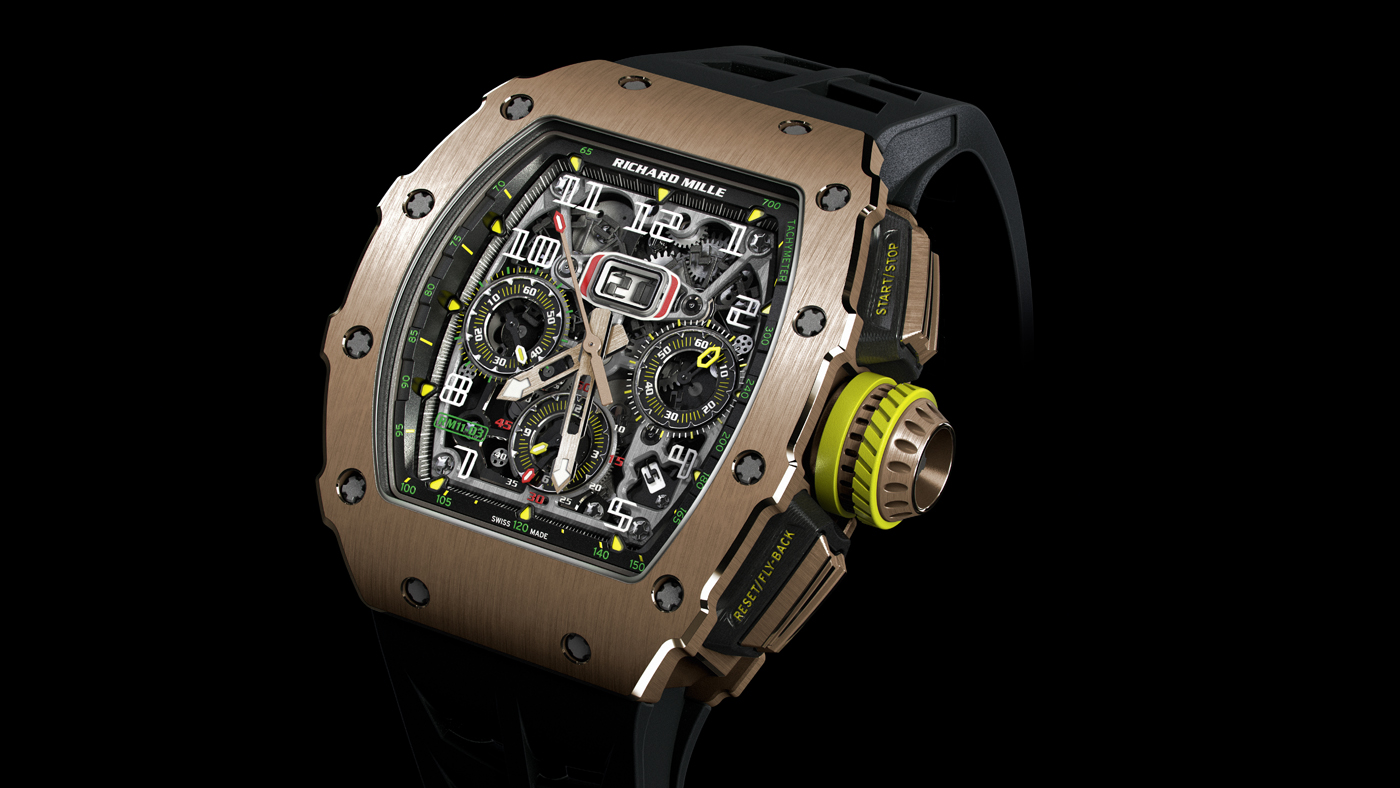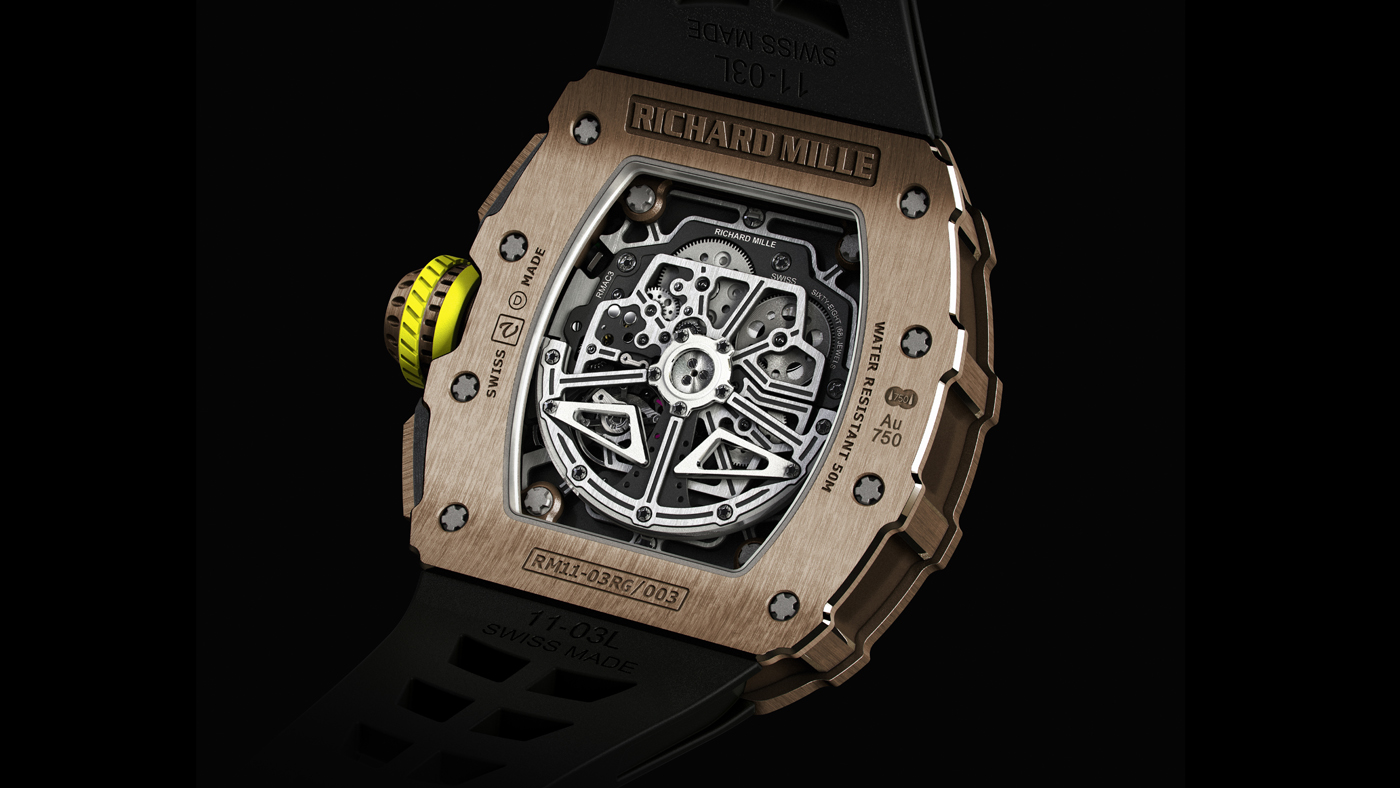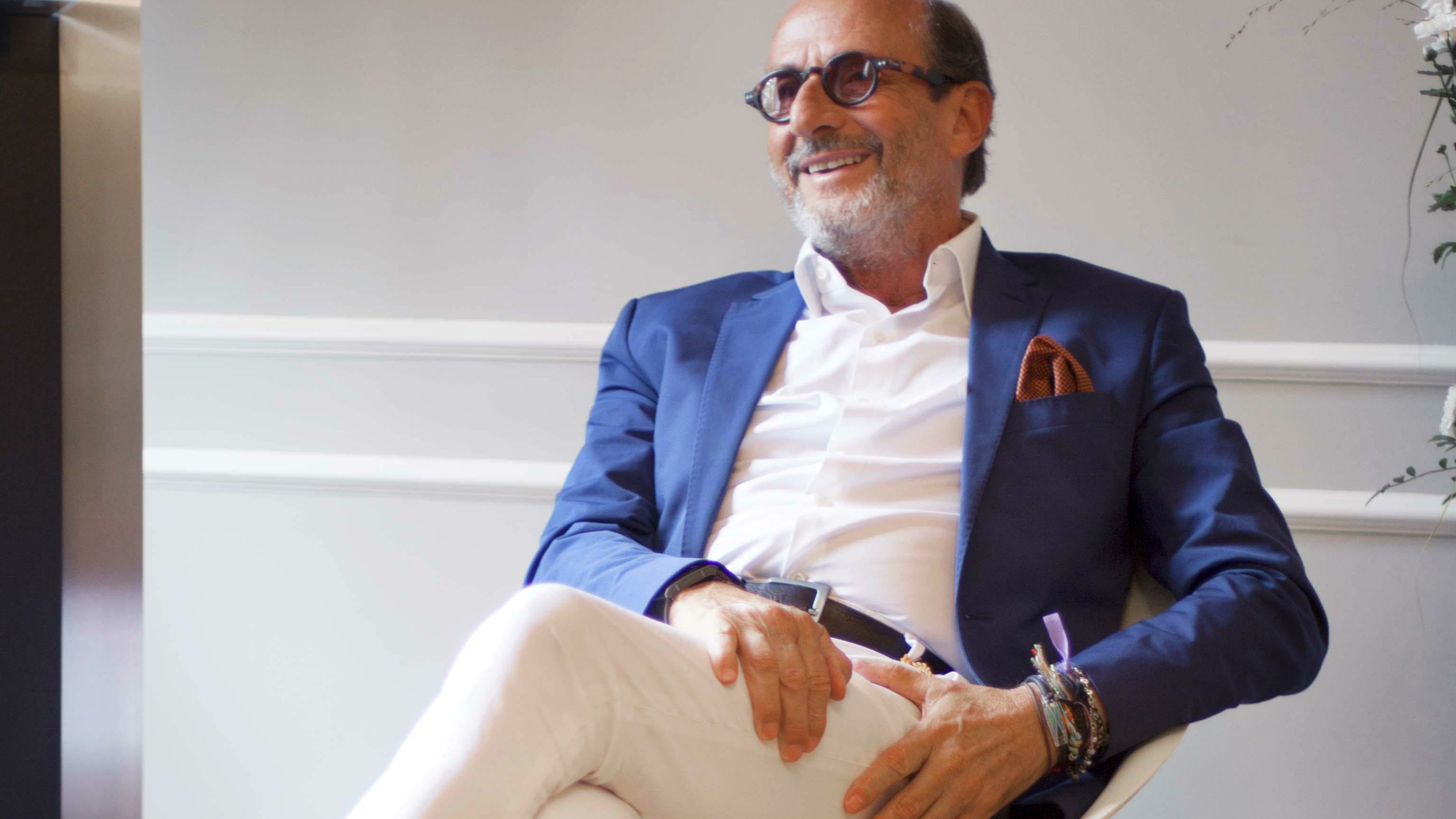Richard Mille: One of a kind
Richard Mille has raised the bar in watchmaking with materials and mechanisms that beggar belief

Fifteen years ago, a younger and more audacious Richard Mille was at Baselworld, the annual watch fair in Switzerland on a marketing mission with a difference. Trying to engender interest in the expensive timepiece he’d just created, the RM 001 Tourbillon, Mille threw the new watch against walls, bounced it off the ground and literally chucked it around as if were a rubber toy. Tourbillons – though named after the French word for whirlwind – are delicate pieces of micro-engineering that counter the effects of gravity on the escapement; by definition of their intricate workings, they should be handled with care, not flung about like a glow stick at a festival.
Witnessing this spectacle, industry executives and experts may well have wondered what sort of madman had burst into their midst – a watchmaker whose approach was so left-field and self-assured that he hadn’t even secured an exhibition stand at the show. Truth be told, Mille had invested everything in his new company: he needed the attention and, quite frankly, he had nothing to lose. Plus, he was safe in the knowledge that his tourbillons are a bionic mix of high-tech materials used in airplanes, motorsport and even satellites; as such, they are resistant to extreme shock and high impact.
Today, a much more contented and relaxed Richard Mille makes 3,600 watches a year (his manufacture has just increased production from 3,000 pieces). This might seem a modest number in watchmaking terms – it is estimated that Rolex makes around a million watches a year – until you know the prices his timepieces command. Richard Mille is arguably the world’s most expensive watch manufacturer: an ‘entry level’ piece, presently the RM 67-01 Automatic Extra Flat, comes in at a cool £101,000, while the average price of his watches is £180,000, with a few skimming the million-dollar mark. What is perhaps surprising is that Mille has upped the ante in an ailing market. While Swiss watch exports have declined for 14 consecutive months, he has seemingly sidestepped the maelstrom because he caters to a niche market of super-rich clients who want a timepiece that is unlike any other.
The Week
Escape your echo chamber. Get the facts behind the news, plus analysis from multiple perspectives.

Sign up for The Week's Free Newsletters
From our morning news briefing to a weekly Good News Newsletter, get the best of The Week delivered directly to your inbox.
From our morning news briefing to a weekly Good News Newsletter, get the best of The Week delivered directly to your inbox.

I’m scheduled to meet the famous watch man in the pretty town of Chantilly, an hour’s drive from central Paris, where Richard Mille is sponsoring the ‘Arts et Elegance’ event; a weekend extravaganza featuring vintage cars, fine wine and thoroughbred horses near the Château de Chantilly. Mille has invited no fewer than 600 guests to the three-day event, centred around the palatial residence that was once home to Louis II de Bourbon, Prince de Condé, a rival to the Sun King, and an individual who believed in grand gestures – a man after Mille’s own heart, in other words.
The prince, who threw lavish parties at the château and was a keen collector of fine art, believed that he would be reborn as a horse and asked his architect to design stables suitable to his rank. Mille is more of an automotive man than an equestrian, with a world-class collection of classic cars. These are the trappings of his wealth, along with a cast of high-profile friends including Jean Todt – president of Formula One’s governing body, the FIA – and superman ambassadors such as sports stars Yohan Blake and Rafael Nadal, for whom Mille has engineered G-force resistant watches that have commanded column space on account of their price tags as well as for their incredibly sophisticated and lightweight complications.
Nadal’s RM27-02 timepiece, which the tennis pro wore at last year’s French Open, was estimated to be worth three-quarters-of-a-million dollars; the watch weighs just 20g and is said to be able to withstand G-forces of up to 5,000 Gs – it is, like Nadal, a sight to behold in motion. Mille rarely gives interviews. Indeed, a few weeks prior to my meeting with the watchmaker, his PR warns me that, “Richard doesn’t like to be tied to times,” which is somewhat ironic given the high-spec time-keeping marvels he creates. In view of his elusiveness, I’m expecting someone shy and retiring; instead, Mille is high-spirited and effusive. He is an hour late for our meeting, but when he eventually arrives, the watchmaker bounds into the room, blowing kisses and apologising for his tardiness.
Warm, eccentric characters may be more commonplace in fashion, but in the world of serious Swiss watchmaking – now all the more austere given the current climate – Mille is something of a rebel. His staff, who all call him by his first name, describe him as “very cool and relaxed,” and he has an avuncular demeanour that is enhanced by his trademark round, tinted glasses and laid-back dress sense: today, he has opted for an unbuttoned shirt with a light sports jacket. I’m told he’s in his sixties, but he looks young for his age.
A free daily email with the biggest news stories of the day – and the best features from TheWeek.com
“You know, we behave like a family,” he says. “It’s a small company. It’s not a multinational, not a corporation. I mean, it’s just people who share the same passion. We have fun, because we are fun!” he exclaims, before adding quietly, “We are serious at the same time. But I always consider my people. [They] cannot work 10 hours a day with no time to enjoy [themselves].”
Although Mille is not a trained watchmaker, his first foray into the watch business came in 1974 at Finhor, a local watchmaking business close to Besançon where he studied marketing. His love of mechanics began at a young age when his father gifted him a watch shortly after his first communion. “I still don’t remember what it was,” he says. “A Longines, perhaps? It was round like that. I opened it the same day and it was impossible to put it back, so my father was very upset.”It wasn’t until he was 50 that he decided to have a go at running his own company. “I arrived at 50 and I said, ‘This is the time to go.’ I had to go!” says Mille in his strong Gallic accent. “And also, [had I] launched this watch 10 or 20 years before, maybe it wouldn’t have worked. I just came at the right moment, with the right product and the right philosophy. It was just perfect.”

Mille pitched himself as a game changer from the get-go. For a start, he established himself with the classic tonneau-shaped case, so that watches would sit comfortably on the wrist. This meant that both the movement and the case (made of three layers) needed to be curved and airtight – a science that required the precision of pioneering nanotechnology.
The watchmaker also incorporated many components used in Formula One, aeronautics and aviation – “My pieces are a combination of my love for cars, aircrafts and watches,” he explains – leading to the brand’s famous advertising tagline: “A racing machine on the wrist.” Early this year, Mille introduced one of his most ambitious and expensive projects to date: the limited-edition RM 50-02 ACJ Tourbillon Split Seconds Chronograph, in collaboration with Airbus.
The watch’s design takes its cue from an ACJ (Airbus Corporate Jets) window, and its case is made of titanium aluminium, which is used in jet turbine blades; a secondary front bezel is made of ATZ white ceramic, one of the hardest materials in the world after diamond. This kind of blue-sky project – one that harnesses a sense of futurism for the here and now – puts Mille at the vanguard of technical development in watchmaking, a position that he unabashedly accepts. “There is no change,” he says. “People [in watchmaking] are only inspired by the 18th or 19th century, but they use modern tools, which for me makes no sense.”
Richard Mille timepieces may be worn by the seriously rich, but the watchmaker makes it clear that his impetus to launch his business began with a boyish fascination with moving mechanisms and ergonomic shapes; he tells me that he created the shape for his first tonneau watch by carving its form from a bar of soap in a hotel room in a moment of inspiration. He also credits the stubborn can-do attitude he has retained throughout his life. “Everybody said a complicated watch is very fragile, so you cannot play golf with it, you cannot do sport, you cannot do anything! You can just put in the safe, waiting for the next generation. I mean, wow! It’s like if you buy a car to put in the garage – it’s ridiculous. So I knew exactly what I wanted to make, because I love this paradox [between] extreme complexity, apparent fragility and extreme resistance.”
While high-octane sports continue to set the pace for hardier and even more mind- boggling complications, it seems that Mille is turning his attention to a more academic source of inspiration: his actor friend John Malkovich, with whom he is collaborating on a new timepiece. Perhaps the tourbillon will reflect the inner workings of the enigmatic actor’s psyche – a new version of Being John Malkovich in precise and intricate detail that will help set in motion personal ideas and dreams.
For his part, Mille has a head full of them. “I’ve just got back from holiday and I went to the factory and told my team I have lots of ideas,” he reveals. “Their response was, ‘No boss, please! No more!’” Just like his watches, there’s just no stopping Richard Mille and his ever-active imagination.

Portraits by Simon Martin

